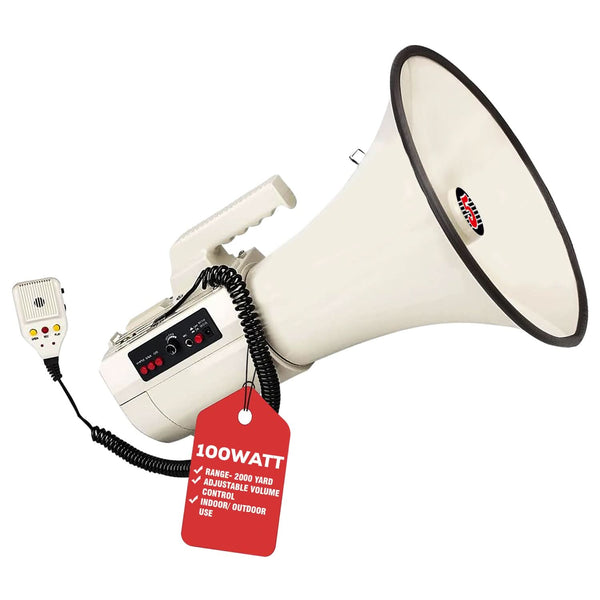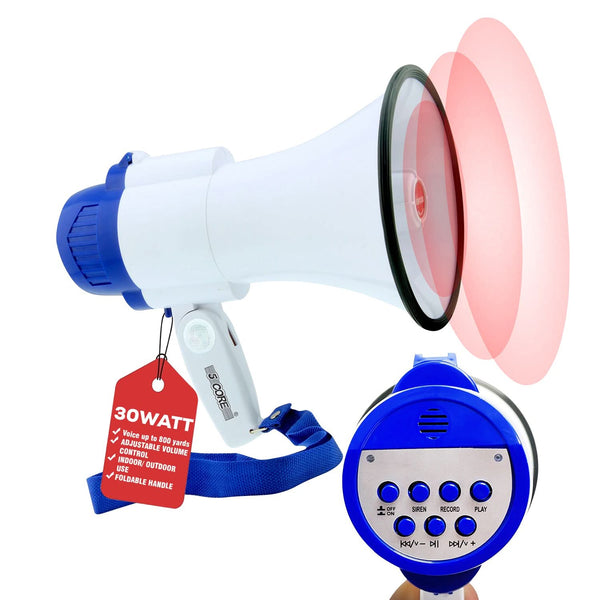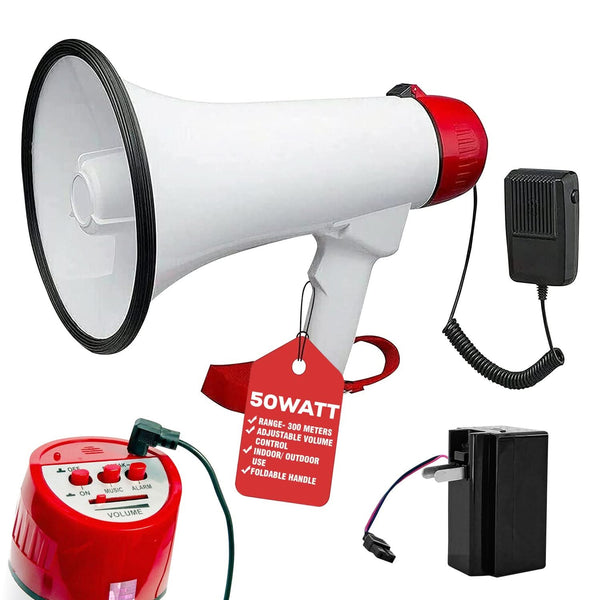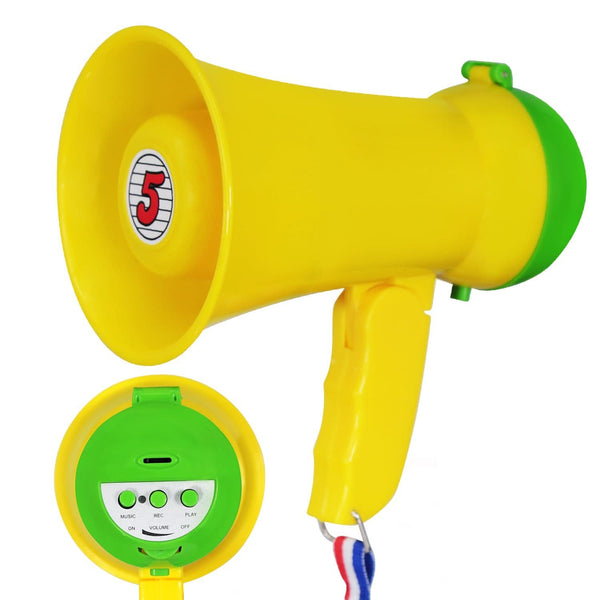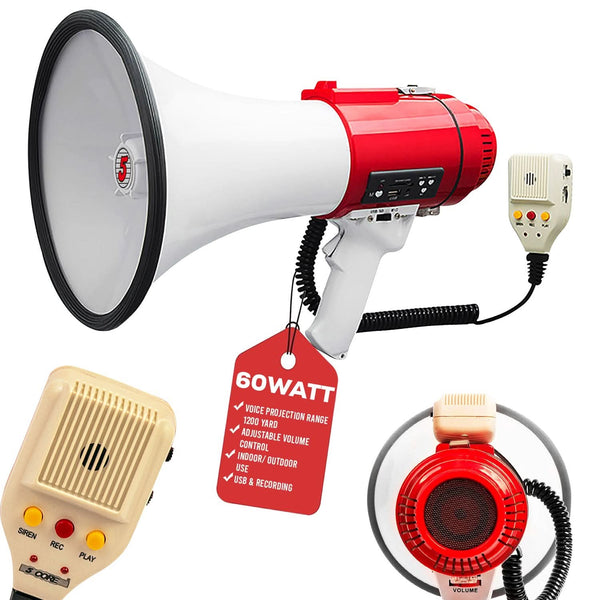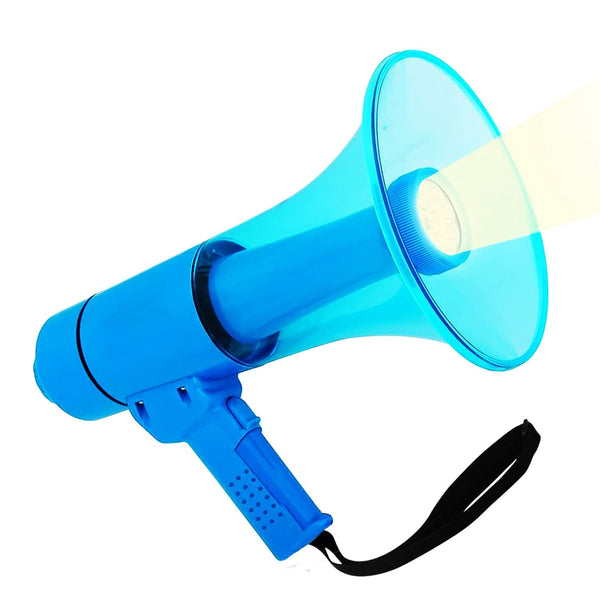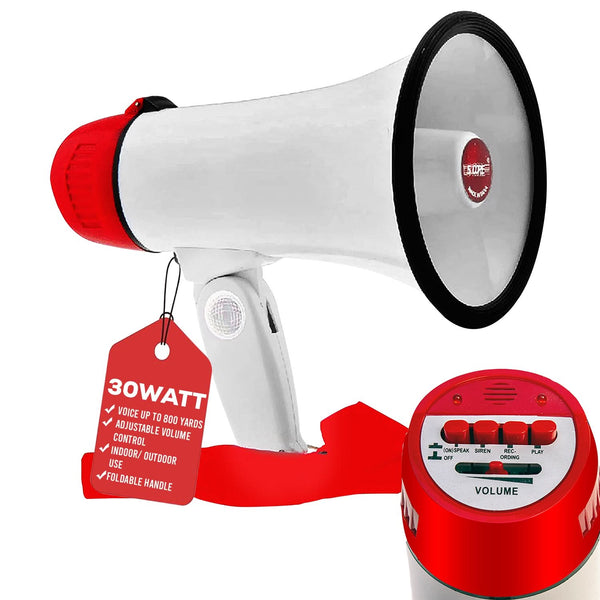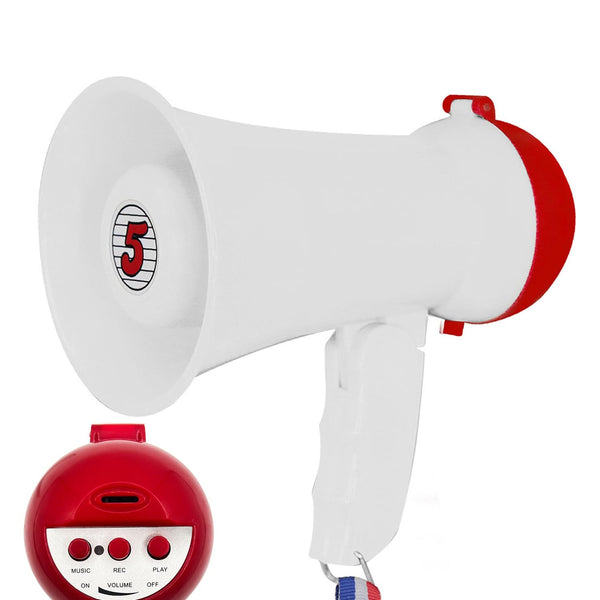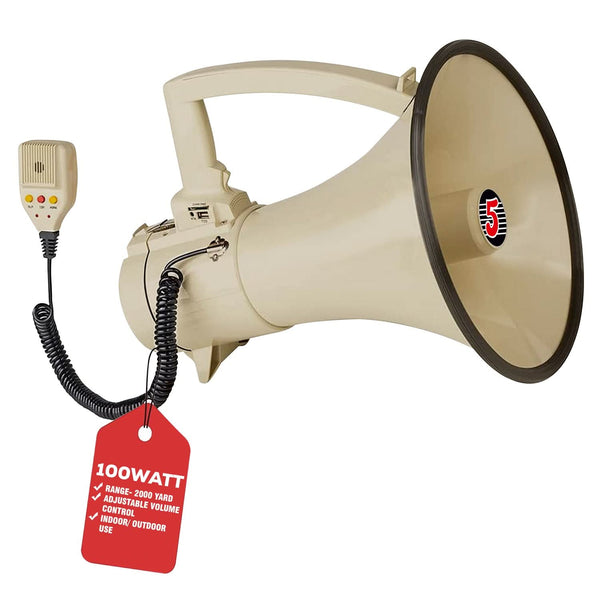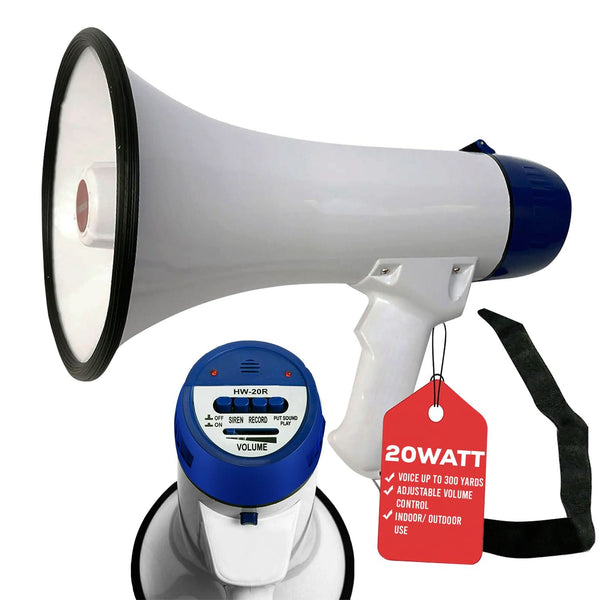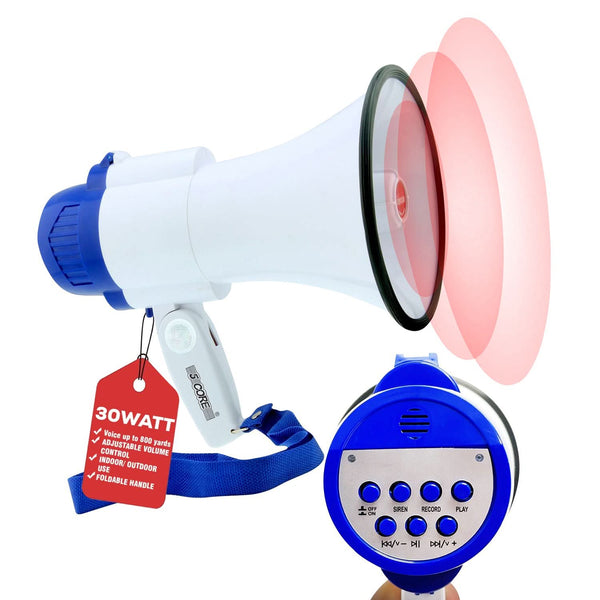
Megaphones have a long history as simple yet effective tools for voice amplifier. Originating in ancient times, early versions included hollowed animal horns or seashells used for public speaking. The modern form began developing in the 17th century with acoustic horns, and the first electric megaphone loud speaker was patented in the early 20th century, revolutionizing voice amplification for large audiences.
Today, handheld megaphones remain essential for clear communication in noisy, open, or crowded environments. These noise maker are widely used in sports, emergencies, public gatherings, and educational events for delivering announcements, directing crowds, and ensuring messages are heard over distance and ambient noise. Their portability and ease of use make them practical despite advanced PA systems.
Megaphones amplify sound by directing the voice through a cone-shaped horn, increasing volume and reach without distortion. This makes them indispensable communication tools for safety and coordination.
What Is a Megaphone and Why You Need One?
A megaphone is a portable device designed to amplify and direct a person’s voice. The basic form—a flared cone—has been used since the 1600s to naturally project sound. Modern versions loud speaker include a microphone, electronic amplifier, and horn loudspeaker built into a compact handheld unit.
Voice amplifier are useful because they provide directional sound projection, allowing the speaker’s voice to travel farther in a focused path. They are lightweight and portable, unlike fixed PA systems, and function without installation, making them ideal for dynamic and moving environments. Many models also include siren or alert modes, essential for crowd management and emergency instructions.
These features make noise makers, also known as bullhorn practical for situations where quick, clear communication is more important than high-fidelity audio, such as in outdoor events, sports, emergency response, and public gatherings.
For more details on bullhorn features and their advantages over PA systems, see: Source- Megaphones: Top 10 Uses - MegaphonesPlus
How to Choose the Right Bullhorn Megaphone
Choosing the right megaphone isn’t just about picking the loudest model — it’s about matching features to the environment, the size of your audience, and the tasks you’ll use it for. Below is a clean, practical expansion of each factor you listed, with buying tips, real-world examples, and a short checklist to make selection faster.
1. Power Output & Range
The wattage of a megaphone loud speaker plays a major role in how far your voice can travel, but it’s not the only factor. Real-world performance depends on environmental conditions such as wind direction, background noise, crowd density, and physical obstructions. Smaller voice amplifier units in the 5–15W range work well for classrooms, indoor gatherings, or small tour groups. Mid-range options between 15–30W are suited for school sports, outdoor community events, and general announcements in open areas. For large gatherings, rallies, or emergency response, megaphone bullhorn above 30W offer the long-distance projection needed. Always consider sound pressure level (SPL) ratings in addition to wattage for a clearer idea of effective range.
2. Battery Type & Runtime
The power source determines how dependable your megaphone will be during continuous use. Disposable batteries like AA or C cells are convenient and widely available, making them ideal for occasional use or long-term storage. Rechargeable lithium-ion packs offer longer life and lower long-term cost, while hybrid noise maker systems that support both types provide essential flexibility during emergencies. Runtime can vary greatly depending on volume level, siren use, and environmental conditions, so choosing a model with a battery indicator or hot-swappable design can prevent unexpected shutdowns during events or critical situations.
3. Siren / Alert Function
A built-in siren is a valuable feature for quickly gaining attention in noisy or chaotic environments. Emergency teams, event coordinators, and crowd control staff rely on this function to immediately direct focus before delivering important messages. Some megaphones include multiple alert tones or dedicated siren volume controls, allowing the user to choose the appropriate sound for different scenarios. A responsive, clearly placed siren button on voice amplifier supports fast activation when seconds matter, making this feature especially important in safety-focused applications.
4. Portability & Ergonomics
Comfort and portability significantly affect how long a megaphone can be used without fatigue. Lightweight designs, balanced handles, and rubberized grips help reduce strain during extended use. Shoulder straps or carrying options add convenience for mobile roles such as tour guides, outdoor instructors, or event marshals who need to move frequently. A well-designed bullhorn loud speaker should feel steady in the hand and manageable even when used for long durations, ensuring the user can focus on communication rather than discomfort.
5. Clarity & Noise Handling
Clear communication is more valuable than raw loudness. A good megaphone emphasizes the mid and high frequencies that make speech intelligible, even at a distance. Horn-shaped noise maker speakers naturally enhance these frequencies, but overall clarity depends on the quality of the driver, microphone sensitivity, and internal audio design. Some models offer tone adjustment features to improve performance in different environments. Effective noise handling reduces distortion and ensures messages remain sharp, even when speaking over wind, crowd noise, or outdoor activity.
6. Durability
Durability is essential for outdoor or heavy-duty use. Weather-resistant housings, sealed controls, and impact-resistant materials protect the megaphone from rain, dust, and accidental drops. ABS plastic is a common choice because it provides a strong balance between weight and toughness. Reinforced microphone cords and sturdy shoulder straps on voice amplifier also contribute to long-term reliability. For teams that operate in rugged conditions, a durable construction ensures the megaphone remains dependable under demanding circumstances.
Which Professionals Commonly Use Megaphones?
Megaphones are widely used in various professions because they offer instant, portable, and reliable voice amplification without requiring complex equipment or power setups. Their versatility makes them essential for roles that involve guiding groups, managing events, or delivering instructions in large or noisy spaces.
Sports Coaches use bullhorn to communicate clearly with players during outdoor training sessions where distance and noise make normal speaking ineffective. Whether giving tactical instructions, running drills, or coordinating field activities, megaphones help ensure consistent communication. Source: NCAA
Cheer Teams rely on megaphones to amplify chants and cues during performances or rehearsals. They help maintain timing, boost crowd engagement, and support synchronized routines even in loud stadium environments.
Source: Varsity
Event Coordinators work in busy environments where quick public communication is essential. Megaphone noise maker loud speaker allow them to direct crowds, make announcements, and coordinate team members at festivals, parades, and outdoor events.
Source: eventmanagerblog
Emergency Services & Safety Officers depend on voice amplifier for evacuation guidance, crowd control, and emergency alerts. In situations where clarity and speed matter, a megaphone ensures instructions cut through noise and reach large groups.
Source: Ready
Teachers & Outdoor Educators use megaphones during field trips, assemblies, and outdoor learning sessions. These environments often lack controlled acoustics, making amplified communication essential for group management and safety.
Source:outdooreducation
Protest Organizers and Community Leaders commonly use noise maker for speeches, chants, and coordinating movement during demonstrations. They help speakers project clearly over traffic noise and large, dispersed crowds.
Source: https://www.amnesty.org
Tour Guides rely on megaphones when leading groups through busy tourist areas, historical sites, or open outdoor attractions. Megaphones help maintain group attention and ensure that information is heard despite distractions.
Source:WFTGA (World Federation of Tourist Guide Associations)
Across all these professions, megaphones offer one major advantage: clear, direct communication without depending on fixed sound systems. Their portability and strong voice projection make them indispensable for anyone who must speak to large groups in open or noisy spaces.
FAQ – Everything About Bull Horn Loud Speakers
Q: How far can a megaphone project sound?
A: Depending on wattage, horn design, and environmental conditions, the effective range can vary from 100 to over 600 meters. Higher wattage and larger horns generally project farther with better clarity.
Q: Do megaphones distort the voice?
A: A slight change in tone is normal because horn speakers emphasize mid and high frequencies. This enhancement actually improves speech intelligibility over long distances.
Q: Are megaphones suitable for indoor use?
A: Yes, but users should lower the volume of loud speaker to reduce echo and feedback. Large halls or gyms may require brief test calls to find the right level.
Q: What type of batteries are best?
A: Emergency recommendations suggest keeping both rechargeable and alkaline batteries. Rechargeables reduce long-term cost, while disposables offer backup reliability.
Q: Is a megaphone the same as a loudspeaker?
A: No. A noise maker is part of a powered or passive audio system, whereas a megaphone is a self-contained handheld amplification device specifically for voice.
Q: Can megaphones be used for music?
A: They are primarily designed for speech projection, not full-range audio. For music or wide-frequency playback, a PA system or external speaker is more suitable.
Q: What wattage megaphone should I choose?
A: For small groups, 5–15W is sufficient; for outdoor or school events, 15–30W works best; for emergency response, rallies, or large crowds, 30–50W or more is recommended.
Q: Are megaphones weatherproof?
A: Some models have water-resistant housings and sealed controls, but not all are fully weatherproof. Check for terms like “weather-resistant,” “IP rating,” or “outdoor-ready” if you expect exposure to rain or dust.
Q: How long does a megaphone battery last?
A: Runtime varies based on volume level and feature usage. Most units run between 3 to 10 hours on fresh batteries. Siren mode uses significantly more power.
Q: Can you use a megaphone without holding it?
A: Yes. Many models include shoulder straps, table stands, or can be mounted on tripods for hands-free use, especially helpful for events and security operations.
Q: Do megaphones require maintenance?
A: Minimal maintenance is needed—just keep the unit dry, clean the microphone area occasionally, and remove batteries during long-term storage to prevent corrosion.
Q: Are megaphones legal in public places?
A: Rules vary by city. Some areas have noise ordinances that restrict volume or usage times. For rallies or large gatherings, checking local regulations is recommended.
Q: Can megaphones work in windy conditions?
A: Yes, but wind can reduce clarity. Speaking slightly off-axis from the wind direction and using a directional mic (if available) improves audibility.
Q: What is the difference between a bullhorn and a megaphone?
A: Both terms refer to the same device. “Bullhorn” is the popular term, while “megaphone” is the technical one.
Q: Do megaphones come with built-in microphones?
A: Most do, and many offer detachable or handheld microphones for better control and reduced handling noise.
Q: Can megaphones store or record messages?
A: Some advanced models include a "record and playback" function, allowing repeated announcements without speaking live.
Closing Note
This page is intended to help readers understand megaphone noise maker from a technical and practical perspective so they can select the right communication device for their environment and requirements. For users comparing specifications or looking for different types of bullhorns and voice amplifiers, 5 Core provides a wide range of models, but the information above applies universally across the category.


